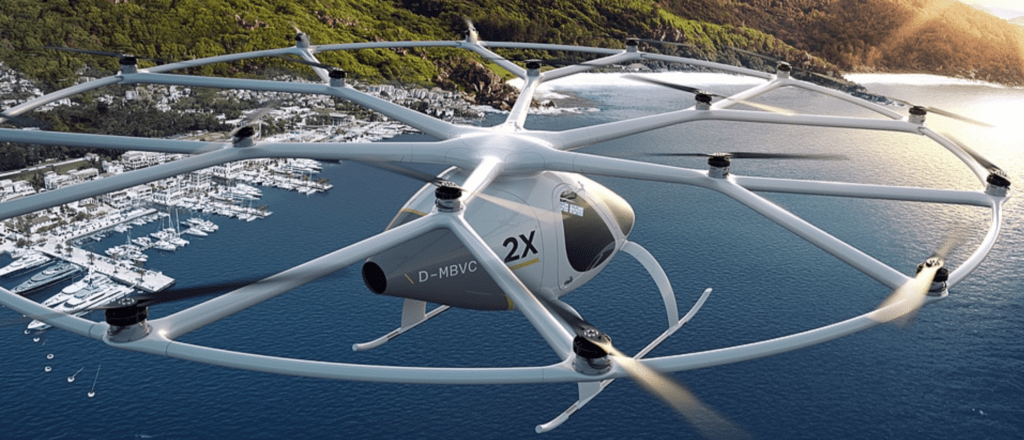As GM of Intel’s drone group, Anil Nanduri has probably got one of the industry’s most exciting jobs. Intel has fingers in all sorts of drone-related pies, from Yuneec to Volocopter to Movidius, to its own drone services and Shooting Star-powered aerial light shows.
Nanduri, whose role at Intel gives him leeway to establish and grow the company’s drone business and generally push the industry’s boundaries, recently spoke to CNET’s Stephen Shankland on a topic we’ve all wondered about at one point or another: passenger drones.
And he’s in a strong position to do that. Intel holds a significant stake in the ambitious German Air Taxi startup Volocopter. Intel’s then-CEO, Brian Krzanich, was even one of the first people to take a test ride.
So what did Nanduri have to say on the topics of passenger drones and aerial transport in general?
Read more: Intel’s Anil Nanduri on 3 Keys to Accelerating Growth in the Drone Industry
Risk and reward
The concept of passenger drones is rich with potential. There’s huge demand for urban mobility options that are relatively environmentally friendly, solve congestion issues and, most importantly, work.
Nanduri sees it as a simple equation with an inevitable result. “A business guy can run the economics and see how the cost models work out at the ecosystem level. When you see that, you know it’s going to happen. And you have these huge pain points. Traffic is only getting more and more congested, and people want instant gratification — they want everything delivered.”
There are innate risks with all things aviation. Gravity is an everpresent danger, but there’s no reason why passenger drones can’t grow to be as safe as their manned counterparts.
“You have 40,000 people per year who die in car accidents. Yet people accept it, and they drive. When you have two hours stuck in traffic and you can shorten that, especially in commuting, you have to adapt. If you go today to Bangalore or Beijing, it’s so congested, you are literally in a parking lot.
Once you see [flying cars], the benefit far overrides the hurdles. If I give you two hours back, you get to watch that movie or spend more time with your family.
They have to be safe. There are always early adopters willing to take bigger risks. But as time progresses, more and more people will get comfortable,” said Nanduri.
Read more: Intel Claims Leadership Role in Drone Regulation Space
Technical challenges
Nanduri was asked about some of the limitations of drone technology. He outlined how passenger drone developers will have to come up with technical solutions to the issues that face all drone users.
“…The biggest challenge, if you look at the physics of a multirotor system, no matter what size and scale, you’re going to have 30 to 45 minutes of battery life with existing battery technology. With a larger drone, you can put more battery in it, but you’re carrying more weight.
That’s why people are looking at hybrid EVTOL systems. They can take advantage of the aerodynamics of tilt-rotor designs. Once you are in flight, you’re more like a traditional aircraft, but then you’re able to take off and land vertically. That has its own challenges, so you see a lot of innovation to extend your flight time,” he suggested.

Social acceptance
Part of the challenge, beyond safety and economic feasibility, is in the human reaction. How will we feel about these new vehicles buzzing above our heads and becoming a regular part of our air traffic?
That’s a headache that can be navigated, according to Nanduri. For starters, they don’t have to be that noisy.
“There is technology that will help make them quieter. If it’s a frequency problem, it’s how the rotors are designed that gives you the changes in the frequency tones,” he said.
“There’s research going on as to how I can make them more human-friendly. These things become barriers to adoption. But at end of the day, the social acceptance comes down to value. If people see value, then they’re willing to deal with some of the irritating aspects that come as part of that.”
Malek Murison is a freelance writer and editor with a passion for tech trends and innovation. He handles product reviews, major releases and keeps an eye on the enthusiast market for DroneLife.
Email Malek
Twitter:@malekmurison
Subscribe to DroneLife here.







[…] the case study, Anil Nanduri, Vice President, GM Drone Group at Intel, expands on the company’s future vision and outlines how […]